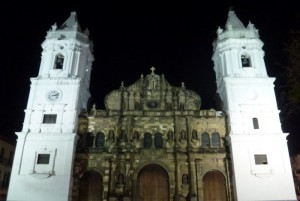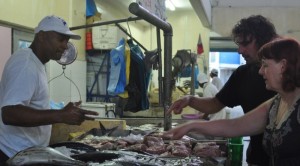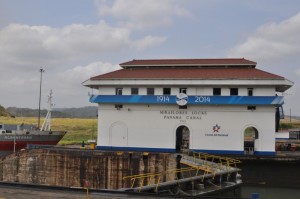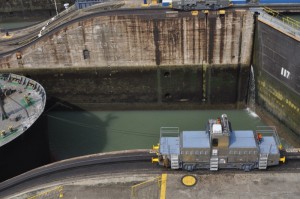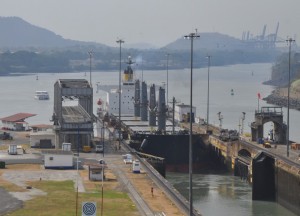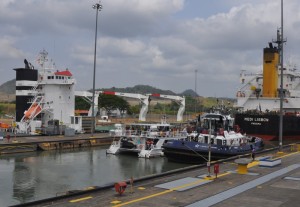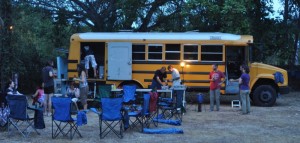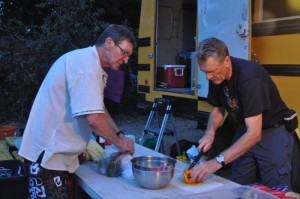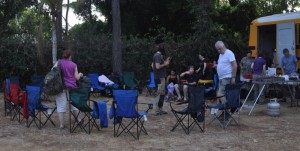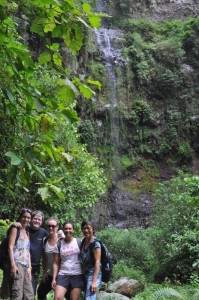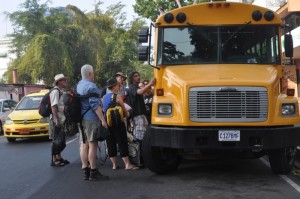
We are all anxious to step into Bessy, a converted school bus making a trip from Panama City to Alaska
My father was a seaman and I first heard about the Panama Canal when I was a kid. I was fascinated by the canal which has been regarded as one of the most remarkable engineering projects in the 20th century. I finally had a chance to see it on the eve of its centennial.
Background
Panama, the southernmost country of Central America linking it with South America, was explored and settled by the Spanish in the 16th century. In 1821, it broke with Spain and joined a union of Nueva Granada which became part of the Republic of Gran Colombia along with Ecuador and Venezuela. When Gran Colombia dissolved in 1831, Panama and Nueva Granada remained joined and the country was later renamed the Republic of Colombia.
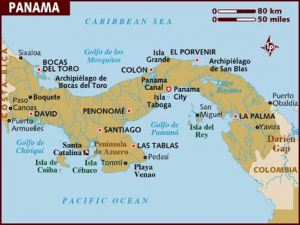 With the backing of the United States (US), Panama seceded from Colombia in 1903. US influence and intervention in Panama continued and the Panama Canal was built by the US Army Corps of Engineers between 1904 and 1914. Panama has a love-and-hate relationship with the US. Anti-US sentiment reached a boiling point in 1964 when a student protest left 27 Panamanians dead and 500 injured. Finally, the Americans agreed to sign the Torrijos-Carter Treaty which guaranteed full Panamanian control of the Canal by the end of 1999 and a complete withdrawal of US military forces.
With the backing of the United States (US), Panama seceded from Colombia in 1903. US influence and intervention in Panama continued and the Panama Canal was built by the US Army Corps of Engineers between 1904 and 1914. Panama has a love-and-hate relationship with the US. Anti-US sentiment reached a boiling point in 1964 when a student protest left 27 Panamanians dead and 500 injured. Finally, the Americans agreed to sign the Torrijos-Carter Treaty which guaranteed full Panamanian control of the Canal by the end of 1999 and a complete withdrawal of US military forces.
The political scene in Panama since 1980s has been dramatic. Colonel Manuel Noriega was the de facto ruler since 1983. In mid-December 1990, Noriega after making himself President declared war on the US leading to US invasion of Panama City on December 20, 1989 under the ‘Operation Just cause’. Noriega finally surrendered to US forces on January 3, 1990 and was convicted of conspiracy to manufacture and distribute cocaine in Miami and imprisoned. He was extradited to France in April 2010 where he was sentenced for ten years for money laundering. In September 2011, Noriega was extradited from France to Panama for trial of violation of human rights. He has remained in prison in Panama ever since.
Since the fall of Noriega, Panama has five presidents including Guillermo Endara (1990-94), Ernesto Perez Balladares (1994-99), Mireya Moscosco (1999-2004), Martin Torrijos (2004-09) and Ricardo-Martinelli (2009-today)
Panama Today
Panama has a population of 3,661,868 (2013 census). Mestizo, Zambo, White and Amerindian comprise 70%, 14%, 10% and 6% of the population respectively. Catholicism is the dominant religion.
Though Panama has its own currency (balboa), the country is in practice dollarized. Panama has achieved remarkable economic growth in recent years. Revenue from canal tolls represents a significant portion of Panama’s GDP and the service industry including tourism is growing fast. The GDP and GDP per capita (nominal) and GDP and per capita (PPP) (2013 estimate) was $40.618 billion and $10,916, and $ 61.540 billion and $16,539 respectively. Despite its status as an upper-middle income nation, it remains a country of stark contrast. About a quarter of the population lived in national poverty in 2013.
With an area of 75,517km², Panama is home to an abundance of tropical plants, animals and birds. It boasts two and three World Heritage Sites namely the Archaeological Site of Panamá Viejo and Historic District of Panamá; Fortifications on the Caribbean Side of Panama: Portobelo-San Lorenzo; Coiba National Park and its Special Zone of Marine Protection; Darien National Park and Talamanca Range-La Amistad Reserves / La Amistad National Park. It has become a popular destination on the South and Central America trail. By 2012, it already received some 2.2 million visitors.
April 13 Sunday: Cartagena, Colombia – Panama City, Panama
We had a short flight of 50 minutes and arrived at the Panama City airport shortly after 2pm. The queue at the immigration control was long and it took us a while to go through. Then we could not find our guide. It turned out that the driver had the guide’s name ‘Tom’ on a placard and did not recognise our group. After some 20 minutes, he came up to our group and picked us up. By the time we arrived at the hotel, it was after 4pm
Our guides Tom from the UK and Yves from Switzerland/France greeted us once we stepped out of the minivan. We met six new members (Victoria, Michelle, Emma, Tim and Chris from the UK and Freddie from Holland). We had our first briefing session at 6pm.
Shortly after 7pm, the whole group headed to the Old Town for a group dinner at 8:30pm. We had an ill-tempered taxi driver who did not drop us at the Plaza de la Independencia and took us to Plaza de Francia. We decided to get off and find our way to meet up with the group in Plaza de la Independencia where the impressive Iglesia Catedral stands. Then we walked to our restaurant next to Plaza Bolívar and Iglesia de San Francisco. As our table was not ready, we walked to Teatro Nacional by the water and had a quick glimpse of the newly opened bridge and the city by night.
As we had a big group, the poor waiter took a long time to take our order. Another half an hour slipped away before I had my cold beer. Almost another hour passed before I had my paella (Spanish seafood rice) which was delicious. By the time we could leave after settling the bill, it was almost 11pm. I enjoy dining out but do not like spend hours in waiting for the food and the bill.
April 14 Monday: Panama City – Panama Canal – Santa Clara (140km; 2hrs)
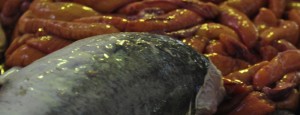 Before setting off at 8am, Victoria, my roommate and I joined Yves on a shopping trip to the fish market. It’s fun to see many different types of fresh seafood in the market at 6:30am. Yves brought king prawns, sword fish, mixed seafood and fish roe for dinner.
Before setting off at 8am, Victoria, my roommate and I joined Yves on a shopping trip to the fish market. It’s fun to see many different types of fresh seafood in the market at 6:30am. Yves brought king prawns, sword fish, mixed seafood and fish roe for dinner.
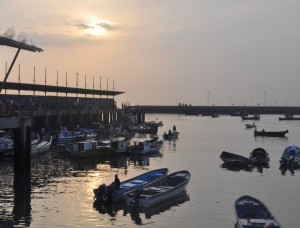 |
While I was having a breakfast, I got a phone call from the management office of my building telling me to find someone to open the door: something was burning inside my flat. I was horrified and immediately send Whatsapp to Karen, a friend and Yam, my handyman to seek help. (Normally I do not take calls from Hong Kong as the roaming charge is excessively high. For some unknown reasons, I decided to take this call.)
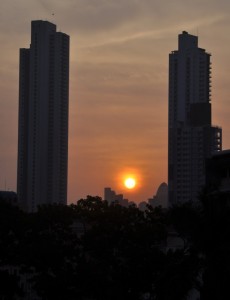 |
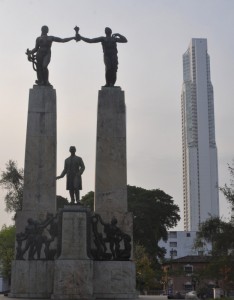 |
Thanks God, Karen who was on a business trip in Kunming immediately responded and called Yam in Hong Kong. Yam then called the management office to tell them how to get into my flat. By the time I arrived at the Panama Canal Visitor Centre shortly after 9am, I was able to Skype Yam who told me that the gas stove had been turned off and my flat was not on fire! Apparently, the friend staying in my flat had not turned off the gas stove before leaving the flat. Another narrow escape!
The Canal was officially opened on August 15, 1914. The 77-km long ship canal connecting the Atlantic Ocean (via the Caribbean Sea) to the Pacific Ocean has played an important role in international maritime trade. The annual traffic of the canal has risen remarkably from about 1,000 ship in its first year of operation to about 20,000 last year. Today, over 1 million vessels have passed through the canal.
There are locks at each end to lift ships up to Gatun Lake, an artificial lake created to reduce the amount of excavation work required for the canal. The third, wider lane of locks is under construction is due to open in 2015. The approximate time to traverse the canal is between 20 and 30 hours.
I was again in a mood for sightseeing and watched the operation of the Canal after an hour from the viewing platform. It is interesting to watch vessels entering the lock at one end and leaving at the other end. I have gone through similar locks in the Three Gorges in China and in Russia. Then I watched a 3D film on the Canal, visited the museum detailing the history and construction of the Canal in 1904-14 and read about its expansion plan.
We left the Canal at 11:30am and reached our camping ground in Santa Clara after 2pm. After a late lunch, Yves showed us how to set up our tent which is light and more airy. I shared the tent with Victoria. At 4pm, I set off on my own to the beach as I wanted to see the area. The others preferred to spend the afternoon by the pool.
I took me 20 minutes to reach the deserted beach. It was Monday and there were only a dozen of swimmers and fishing boats. Some men were repairing the nets. I got into the water which is nice and cool for five minutes. I got back to the camp ground shortly after 5pm. It was hot and I got into the pool doing aqua-aerobic exercise.
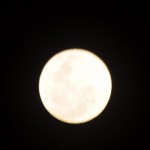 Tonight, Gordon and Dave were our chef: they did a fantastic job. We had delicious pan-fried fish roe as starter and fried fish steak and mixed seafood with pasta as the main course. We even had proper folding canvas chairs to sit on. What a luxury!
Tonight, Gordon and Dave were our chef: they did a fantastic job. We had delicious pan-fried fish roe as starter and fried fish steak and mixed seafood with pasta as the main course. We even had proper folding canvas chairs to sit on. What a luxury!
We had a lunar eclipse and the best viewing time was from 2 to 4am. It was so hot and noisy (traffic noise from the Pan-American Highway) that I could not sleep. I got up around 2am and watched the phenomenon for an hour and a half. As it was cloudy, it was impossible to see a red/orange moon at all. I only had two hours’ sleep.
April 15 Tuesday: Santa Clara – Boquete (364km; 7hrs)
We had breakfast at 7am and had to pack to go by 8am. When I tried to lift and pass a heavy bag to the baggage team, I hurt my back. I had sciatic pains on several occasions and knew something was wrong. For the rest of the day, I had problems in standing and moving around. Not a good start!
After a long drive, we finally arrived at Refugio del Rio around 4pm. I shared a room with four ladies. The hostel run by a family is lovely with a hot tub in the garden. The kitchen is full-equipped. I immediately went to the supermarket and brought minced meat and rice for dinner. I had a simple but nice meal. After dinner, I had a good soak in the hot tub which is good for my back.
April 16 Wednesday: Boquete
Boquete surrounded by misty hills in the Chiriqui Province offers a wide range of outdoor activities. One can do horse riding, rock climbing, rafting, a coffee farm tour and climbing Volcán Barú (3478m). There are also some interesting treks including the Quetzales Trail.
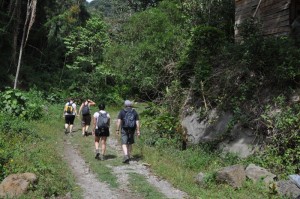 |
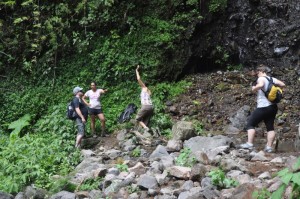 |
Since I had a back problem, strenuous activities would be out of the question. So I joined Tim, Nam, Emma and Amy on a short pipeline and waterfall trail. We set off around 10:30am and finished the walk at noon. The trail is shady and easy but not scenic. We also did not spot any quetzals.
I often miss seafood on the road. Today would be my fish day: I brought three fillets costing under $6. I cooked a piece with garlic and tomato for lunch and had two pieces pan-fried for dinner. The fish was delicious and I felt satisfied and happy. Life can be very simple and a good meal can cost nothing! I spent the rest of the day on the photos and my website.
Before going to bed, I went to the hot tub once more. The back pain was half gone.
April 17 Thursday: Boquete, Panama – Manuel Antonio, Costa Rica (300km; 5 hrs driving + 3hrs 30min at border)
We had an early start at 7am. By the time we arrived at the border, it was only 8:45am. But the immigration control service was ridiculously slow: it took us almost three hours to exit Panama. It is the worst border experience.
First, we had to bring all our belongings to a windowless room where a trained dog sniffed our bags. We all had to stand behind a table. Of course, we had no drug in our bags!
Then we queued up for two hours (with only about 30 people in front of us) to get a stamp on our passport. While we were not required to show the Yellow Fever vaccine record on entry, the staff suddenly demanded us to show proof. My vaccine record book was at the bottom of my suitcase and I had difficulties in getting in out. Fortunately Yves charmed the officer and Lachi and I got away without showing it. But Nam and Freddie (Jr) had to run back to the bus to get theirs upon the insistence of another officer.
We were relieved when all of us got the exit stamp on our passport. Back on the bus, we drove about 200m and arrived at the immigration control on the Costa Rica side by 12 noon.
Remarks
Our school bus zipped through Panama within five days and I have only seen the country from the bus window along the Pan-American Highway. The Old Town of Panama City looks interesting with impressive architectures. But I am unable to see its true face and colours during the night tour. There are four other natural World Heritage Sites which I have yet to see.
The visit to the world famous Panama Canal is worthwhile. The Canal will be celebrating its centennial on August 15. It will also be expanded to cater for today’s vessels. I have no doubt that the Canal will continue to play a pivotal role in the country’s economy as well as its future.
During my stay in Panama, I decided to change the routing of my round-the-world ticket so that I could fly from Bogota to Europe instead of from Rio. In this way, I shall save both time and money as a single ticket from Central America to Rio can cost over $800. As a result, I shall return to Panama at the end of my overland trip in mid-May. I should be able to see other parts of Panama on my second trip.



